Researches
Wastewater Treatment: Wet Air Oxidation As A Precursor To Biological Treatment
Views : 10
Wastewater Treatment: Wet Air Oxidation As A Precursor To Biological Treatment
Source: https://www.elsevier.com
Author: Dionissios Mantzavinos, Mortaza Sahibzada, Andrew G. Livingston, Ian S. Metcalfe, Klaus Hellgardt
Usually dispatched in 2 to 3 days
Usually dispatched in 2 to 3 days
Category:
Researches
The use of wet air oxidation as a pretreatment step in the context of an integrated chemical/biological process was investigated for model organic-containing wastewaters. It was found that the selection of suitable wastewaters and pretreatment conditions (i.e. temperature, residence time, use of catalysts) was significant for the effective application of an integrated process.
Only logged in customers who have purchased this product may leave a review.
Related books
Water Desalination Using Solar Thermal Collectors Enhanced by Nanofluids
Introduction
In the future, the world is confronted with energy and freshwater shortage. Desalination of brackish or seawater is one of the most important ways to solve the water scarcity issue [1, 2]. The use of solar energy or waste heat sources is acceptable for water-producing systems of such a small size [3–5]. The relevancy of nanomaterials is to realize the best attainable properties within the smallest possible loadings through homogenized distribution and stable suspension of these nanoparticles[6–11]. Often, heat transfer improvement in solar collectors is one of the basic problems in energy saving, compact designs, and different operating temperatures. Researchers also investigated the multiwalled carbon nanotubes (MWCNTs) and water nanofluids with a pH of 3.5, 6.5, and 9.5, and Triton X-100 as a surfactant (0.2 wt %) using flat-plate solar collectors. It was found that the nanofluids have better heat transfer performance in acidic and alkaline water due to the influence of the isoelectric point. The higher efficiency (67 %) was obtained at pH 9.5 and 3.5 with a water flow rate of 0.0333 kg s–1. A stable nanofluid based on ethylene glycol-containing nanosheets of graphene oxide was prepared by Yu et al. [12]. The improvement in thermal conductivity relies strongly on the volume fraction of the nanosheet of graphene oxide and increases with higher nanoparticle loading. The heat efficiency was enhanced up to 61.0 % using a nanosheet loading of 5.0 vol %. For seven days, the thermal conductivity of the fluids remained almost constant, which suggests their high stability. In the measured temperature range, the enhancement value was independent of the temperature. Peyghambarzadeh et al. [13, 14] studied force convection techniques in an excessively base water nanofluid, which was experimentally compared to water in a vehicle heat exchanger with different nanofluid loadings. It was experimentally investigated to improve the rate of heat transfer. The variable effect of the inlet temperature of the fluid in the heat exchanger on the heat transfer coefficient was evaluated. The findings showed that the incremental fluid circulation rate would increase the output rate of heat transfer, while the temperature of the fluid entering the heat exchanger had negligible effects. Meanwhile, water nanofluid subservience at low-volume loadings would increase the heat transfer rate efficiency by approximately 44 % compared to water
Water Desalination Using Solar Thermal Collectors Enhanced by Nanofluids
Introduction
In the future, the world is confronted with energy and freshwater shortage. Desalination of brackish or seawater is one of the most important ways to solve the water scarcity issue [1, 2]. The use of solar energy or waste heat sources is acceptable for water-producing systems of such a small size [3–5]. The relevancy of nanomaterials is to realize the best attainable properties within the smallest possible loadings through homogenized distribution and stable suspension of these nanoparticles[6–11]. Often, heat transfer improvement in solar collectors is one of the basic problems in energy saving, compact designs, and different operating temperatures. Researchers also investigated the multiwalled carbon nanotubes (MWCNTs) and water nanofluids with a pH of 3.5, 6.5, and 9.5, and Triton X-100 as a surfactant (0.2 wt %) using flat-plate solar collectors. It was found that the nanofluids have better heat transfer performance in acidic and alkaline water due to the influence of the isoelectric point. The higher efficiency (67 %) was obtained at pH 9.5 and 3.5 with a water flow rate of 0.0333 kg s–1. A stable nanofluid based on ethylene glycol-containing nanosheets of graphene oxide was prepared by Yu et al. [12]. The improvement in thermal conductivity relies strongly on the volume fraction of the nanosheet of graphene oxide and increases with higher nanoparticle loading. The heat efficiency was enhanced up to 61.0 % using a nanosheet loading of 5.0 vol %. For seven days, the thermal conductivity of the fluids remained almost constant, which suggests their high stability. In the measured temperature range, the enhancement value was independent of the temperature. Peyghambarzadeh et al. [13, 14] studied force convection techniques in an excessively base water nanofluid, which was experimentally compared to water in a vehicle heat exchanger with different nanofluid loadings. It was experimentally investigated to improve the rate of heat transfer. The variable effect of the inlet temperature of the fluid in the heat exchanger on the heat transfer coefficient was evaluated. The findings showed that the incremental fluid circulation rate would increase the output rate of heat transfer, while the temperature of the fluid entering the heat exchanger had negligible effects. Meanwhile, water nanofluid subservience at low-volume loadings would increase the heat transfer rate efficiency by approximately 44 % compared to water
Desalination: From Ancient To Present And Future
Abstract:
Water is life, and without water, there would be no civilizations and a vacant Earth. Water is considered an abundant natural resource on the earth. Water covers 3/4 of the surface. However, 97% of the available water on the earth is salty oceanic water, and only a tiny fraction (3%) is freshwater. This small portion of the available water supplies the needs of humans and animals. However, freshwater exists in underground, rivers, and lakes and is insufficient to cover all the world’s water demands. Thus, water saving, water reuse, rainwater harvesting, stormwater utilization, and desalination are critical for maintaining water supplies for the future of humanity. Desalination has a long history spanning centuries from ancient times to the present. In the last two decades, desalination has been rapidly expanding to meet water needs in stressed water regions of the world. Yet, there are still some problems with its implementation in several areas of the world. This review provides a comprehensive assessment of the history of desalination for wiser and smarter water extraction and uses to sustain and support the water needs of the earth’s inhabitants.
Desalination: From Ancient To Present And Future
Abstract:
Water is life, and without water, there would be no civilizations and a vacant Earth. Water is considered an abundant natural resource on the earth. Water covers 3/4 of the surface. However, 97% of the available water on the earth is salty oceanic water, and only a tiny fraction (3%) is freshwater. This small portion of the available water supplies the needs of humans and animals. However, freshwater exists in underground, rivers, and lakes and is insufficient to cover all the world’s water demands. Thus, water saving, water reuse, rainwater harvesting, stormwater utilization, and desalination are critical for maintaining water supplies for the future of humanity. Desalination has a long history spanning centuries from ancient times to the present. In the last two decades, desalination has been rapidly expanding to meet water needs in stressed water regions of the world. Yet, there are still some problems with its implementation in several areas of the world. This review provides a comprehensive assessment of the history of desalination for wiser and smarter water extraction and uses to sustain and support the water needs of the earth’s inhabitants.
Adsorption of Heavy Metals from Multi-Metal Aqueous Solution by Sunflower Plant Biomass-Based Carbons
Abstract
This study reports the competitive adsorption
of Ni(II), Cd(II) and Cr(VI) onto sunflower waste biomass
carbons, viz. sunflower head carbon and sunflower stem
carbon from multi-metal aqueous solution.
Adsorption of Heavy Metals from Multi-Metal Aqueous Solution by Sunflower Plant Biomass-Based Carbons
Abstract
This study reports the competitive adsorption
of Ni(II), Cd(II) and Cr(VI) onto sunflower waste biomass
carbons, viz. sunflower head carbon and sunflower stem
carbon from multi-metal aqueous solution.
Adsorption of Heavy Metal Ions from Aqueous Solutions onto Rice Husk Ash Low Cost Adsorbent
Abstract
In the present study, adsorption of Zn (II), Cd (II) and Hg (II) ions on rice husk ash (RHA) has been investigated in single, binary and tertiary systems.
Batch experiments were also carried out for mono-and multi-component systems with varying metal ions concentrations (mg/l) to investigate the competitive adsorption characteristics.
Adsorption of Heavy Metal Ions from Aqueous Solutions onto Rice Husk Ash Low Cost Adsorbent
Abstract
In the present study, adsorption of Zn (II), Cd (II) and Hg (II) ions on rice husk ash (RHA) has been investigated in single, binary and tertiary systems.
Batch experiments were also carried out for mono-and multi-component systems with varying metal ions concentrations (mg/l) to investigate the competitive adsorption characteristics.
Artificial Neural Network Model for the Prediction of Groundwater Quality
The present article delves into the examination of groundwater quality, based on WQI, for drinking purposes in Baghdad City. Further, for carrying out the investigation, the data was collected from the Ministry of Water Resources of Baghdad, which represents water samples drawn from 114 wells in Al-Karkh and Al-Rusafa sides of Baghdad city. With the aim of further determining WQI, four water parameters such as (i) pH, (ii) Chloride (Cl), (iii) Sulfate (SO4), and (iv) Total dissolved solids (TDS), were taken into consideration. Additionally, to anticipate changes in groundwater WQI, IBM® SPSS® Statistics 19 software (SPSS) was used to develop an artificial neural network model (ANNM). With the application of this ANNM model, the results obtained illustrated high prediction efficiency, as the sum of squares error functions (for training and testing samples) and coefficient of determination (R2), were found to be (0.038 and 0.005) and 0.973, respectively.
Artificial Neural Network Model for the Prediction of Groundwater Quality
The present article delves into the examination of groundwater quality, based on WQI, for drinking purposes in Baghdad City. Further, for carrying out the investigation, the data was collected from the Ministry of Water Resources of Baghdad, which represents water samples drawn from 114 wells in Al-Karkh and Al-Rusafa sides of Baghdad city. With the aim of further determining WQI, four water parameters such as (i) pH, (ii) Chloride (Cl), (iii) Sulfate (SO4), and (iv) Total dissolved solids (TDS), were taken into consideration. Additionally, to anticipate changes in groundwater WQI, IBM® SPSS® Statistics 19 software (SPSS) was used to develop an artificial neural network model (ANNM). With the application of this ANNM model, the results obtained illustrated high prediction efficiency, as the sum of squares error functions (for training and testing samples) and coefficient of determination (R2), were found to be (0.038 and 0.005) and 0.973, respectively.
Biofouling of Water Treatment Membranes: A Review of the Underlying Causes, Monitoring Techniques and Control Measures
Biofouling is a critical issue in membrane water and wastewater treatment as it greatly compromises the efficiency of the treatment processes. It is difficult to control, and significant economic resources have been dedicated to the development of effective biofouling monitoring and control strategies. This paper highlights the underlying causes of membrane biofouling and provides a review on recent developments of potential monitoring and control methods in water and wastewater treatment with the aim of identifying the remaining issues and challenges in this area.
Biofouling of Water Treatment Membranes: A Review of the Underlying Causes, Monitoring Techniques and Control Measures
Biofouling is a critical issue in membrane water and wastewater treatment as it greatly compromises the efficiency of the treatment processes. It is difficult to control, and significant economic resources have been dedicated to the development of effective biofouling monitoring and control strategies. This paper highlights the underlying causes of membrane biofouling and provides a review on recent developments of potential monitoring and control methods in water and wastewater treatment with the aim of identifying the remaining issues and challenges in this area.
Renewable Energy-Driven Desalination: New Trends And Future Prospects Of Small Capacity Systems
Abstract:
New trends and future prospects for small capacity systems of Renewable Energy-driven Desalination (REDES) are reviewed and assessed in this paper over a nominal desalination capacity range of 3–1000 m3/d. A thorough literature review is reported in order to evaluate current research and developing activities. Outstanding commercial prospects in the near future are identified for two off-grid REDES technologies under development. First, wave energy converters with direct coupling to seawater desalination. Second, solar micro gas turbines with biofuel backup coupled to reverse osmosis (RO) desalination and/or zero liquid discharge water treatment. These systems, as well as mature REDES plants (namely PV/RO and wind turbines/RO), will benefit from forthcoming advances in energy efficiency in the RO process itself. The Closed Circuit RO desalination (CCROTM) concept may be a key configuration for enhancing RE-driven RO desalination. Additionally, opportunities for innovation in seawater RO desalination with variable power consumption are highlighted. On the other hand, our conclusions highlight opportunities for developing novel portable REDES systems based on solar membrane distillation with a portable linear Fresnel concentrator manufactured by SOLATOM. Additionally, the concept of portable systems could foster the commercial development of microbial desalination cells combined with solar PV energy and RO powered by tidal currents.
Renewable Energy-Driven Desalination: New Trends And Future Prospects Of Small Capacity Systems
Abstract:
New trends and future prospects for small capacity systems of Renewable Energy-driven Desalination (REDES) are reviewed and assessed in this paper over a nominal desalination capacity range of 3–1000 m3/d. A thorough literature review is reported in order to evaluate current research and developing activities. Outstanding commercial prospects in the near future are identified for two off-grid REDES technologies under development. First, wave energy converters with direct coupling to seawater desalination. Second, solar micro gas turbines with biofuel backup coupled to reverse osmosis (RO) desalination and/or zero liquid discharge water treatment. These systems, as well as mature REDES plants (namely PV/RO and wind turbines/RO), will benefit from forthcoming advances in energy efficiency in the RO process itself. The Closed Circuit RO desalination (CCROTM) concept may be a key configuration for enhancing RE-driven RO desalination. Additionally, opportunities for innovation in seawater RO desalination with variable power consumption are highlighted. On the other hand, our conclusions highlight opportunities for developing novel portable REDES systems based on solar membrane distillation with a portable linear Fresnel concentrator manufactured by SOLATOM. Additionally, the concept of portable systems could foster the commercial development of microbial desalination cells combined with solar PV energy and RO powered by tidal currents.
Calibration And Verification Of The Hydraulic Model For Blue Nile River from Roseries Dam To Khartoum City
ABSTRACT:
This research represents a practical attempt applied to calibrate and verify a hydraulic model for the Blue Nile River. The calibration procedures are performed using the observed data for a previous period and comparing them with the calibration results while verification requirements are achieved with the application of the observed data for another future period and comparing them with the verification results. The study objective covered a relationship of the river terrain with the distance between the assumed points of the dam failures along the river length. The computed model values and the observed data should conform to the theoretical analysis and the overall verification performance of the model by comparing it with another set of data. The model was calibrated using data from gauging stations (Khartoum, Wad Medani, downstream Sennar, and downstream Roseires) during the period from the 1st of May to 31 of October 1988 and the verification was done using the data of the same gauging stations for years 2003 and 2010 for the same period. The required available data from these stations were collected, processed and used in the model calibration. The geometry input files for the HEC-RAS models were created using a combination of ArcGIS and HEC-GeoRAS. The results revealed high correlation (R2 ˃ 0.9) between the observed and calibrated water levels in all gauging stations during 1988 and also high correlation between the observed and verification water levels was obtained in years 2003 and 2010. Verification results with the equation and degree of correlation can be used to predict future data of any expected data for the same stations.
Calibration And Verification Of The Hydraulic Model For Blue Nile River from Roseries Dam To Khartoum City
ABSTRACT:
This research represents a practical attempt applied to calibrate and verify a hydraulic model for the Blue Nile River. The calibration procedures are performed using the observed data for a previous period and comparing them with the calibration results while verification requirements are achieved with the application of the observed data for another future period and comparing them with the verification results. The study objective covered a relationship of the river terrain with the distance between the assumed points of the dam failures along the river length. The computed model values and the observed data should conform to the theoretical analysis and the overall verification performance of the model by comparing it with another set of data. The model was calibrated using data from gauging stations (Khartoum, Wad Medani, downstream Sennar, and downstream Roseires) during the period from the 1st of May to 31 of October 1988 and the verification was done using the data of the same gauging stations for years 2003 and 2010 for the same period. The required available data from these stations were collected, processed and used in the model calibration. The geometry input files for the HEC-RAS models were created using a combination of ArcGIS and HEC-GeoRAS. The results revealed high correlation (R2 ˃ 0.9) between the observed and calibrated water levels in all gauging stations during 1988 and also high correlation between the observed and verification water levels was obtained in years 2003 and 2010. Verification results with the equation and degree of correlation can be used to predict future data of any expected data for the same stations.
Nanotechnology in Water Treatment
ABSTRACT Drinking water is unfortunately becoming a rare luxury on our planet.On the other hand, with a trend of population growth, need for water which is essential to life,is becomingbigger every day.Practical application of nanotechnology in saving water worldwide is in using nanoparticles in detection of water pollution and water purification. This knowledge has importance in medicine and public health, so as in environment safety.Possible application areas of nanotechnology in field of purification and treatment of water are in filtration, catalytic and separation processes, ion exchanging, sensitive pollutant detection,etc.Nanotechnology could be the main solution in future fortreatment of surface water,groundwater, and waste water contaminated by toxic metal ions, organic and inorganic solutes, and microorganisms.
Nanotechnology in Water Treatment
ABSTRACT Drinking water is unfortunately becoming a rare luxury on our planet.On the other hand, with a trend of population growth, need for water which is essential to life,is becomingbigger every day.Practical application of nanotechnology in saving water worldwide is in using nanoparticles in detection of water pollution and water purification. This knowledge has importance in medicine and public health, so as in environment safety.Possible application areas of nanotechnology in field of purification and treatment of water are in filtration, catalytic and separation processes, ion exchanging, sensitive pollutant detection,etc.Nanotechnology could be the main solution in future fortreatment of surface water,groundwater, and waste water contaminated by toxic metal ions, organic and inorganic solutes, and microorganisms.
Applications of Nanotechnology in Wastewater Treatment
Abstract:
Waste water treatment issues have been a growing problems these days. Its treatment is becoming must in this Industrial world. Nanoparticles have a great potential to be used in waste water treatment. Some of the unique characteristics of it having high surface area can be used efficiently for removing toxic metal ions, disease causing microbes, inorganic and organic solutes from water. The different classes of nanomaterials also have the authority to be efficient for water treatment like metal-containing nanoparticles, carbonaceous nanomaterials and zeolites. The review includes recent development in nanotechnology for water and wastewater treatment. The paper covers nanomaterials that enables the applications, advantages and limitations as compared to existing processes. Nanotechnology has led to various efficient ways for treatment of waste water in a more precise and accurate way on both small and large scale.
Applications of Nanotechnology in Wastewater Treatment
Abstract:
Waste water treatment issues have been a growing problems these days. Its treatment is becoming must in this Industrial world. Nanoparticles have a great potential to be used in waste water treatment. Some of the unique characteristics of it having high surface area can be used efficiently for removing toxic metal ions, disease causing microbes, inorganic and organic solutes from water. The different classes of nanomaterials also have the authority to be efficient for water treatment like metal-containing nanoparticles, carbonaceous nanomaterials and zeolites. The review includes recent development in nanotechnology for water and wastewater treatment. The paper covers nanomaterials that enables the applications, advantages and limitations as compared to existing processes. Nanotechnology has led to various efficient ways for treatment of waste water in a more precise and accurate way on both small and large scale.
Correlating BOD5 and COD of Sewage in Wastewater Treatment Plants Case Study Al- Diwaniyah WWTP in Iraq
ABSTRACT
This study aims to establish an empirical correlation between biochemical oxygen demand (BOD5) and chemical oxygen demand (COD) of the sewage flowing in Al-Diwaniyah wastewater treatment plant. The strength of the wastewater entering the plant varied from medium to high. High concentrations of BOD5 and COD in the effluent were obtained due to the poor performance of the plant. This was observed from the BOD5 /COD ratios that did not confirm with the typical ratios for the treated sewage. To improve the performance of this plant, regression equations for BOD5 and COD removal percentages were suggested which can be used to facilitate rapid effluent assessment or optimal process control. The equations relating the percentage removal of BOD5(y) with influent BOD5(x), y= 0.044x + 80.66 and the percentage removal of COD (y) with influent COD (x), y= 0.045x + 55.15 were found with high correlation R2 =0.72 and 0.86 respectively. Key words: Sewage treatment, BOD5, COD, BOD5/COD ratio, BOD5&COD correlations
Correlating BOD5 and COD of Sewage in Wastewater Treatment Plants Case Study Al- Diwaniyah WWTP in Iraq
ABSTRACT
This study aims to establish an empirical correlation between biochemical oxygen demand (BOD5) and chemical oxygen demand (COD) of the sewage flowing in Al-Diwaniyah wastewater treatment plant. The strength of the wastewater entering the plant varied from medium to high. High concentrations of BOD5 and COD in the effluent were obtained due to the poor performance of the plant. This was observed from the BOD5 /COD ratios that did not confirm with the typical ratios for the treated sewage. To improve the performance of this plant, regression equations for BOD5 and COD removal percentages were suggested which can be used to facilitate rapid effluent assessment or optimal process control. The equations relating the percentage removal of BOD5(y) with influent BOD5(x), y= 0.044x + 80.66 and the percentage removal of COD (y) with influent COD (x), y= 0.045x + 55.15 were found with high correlation R2 =0.72 and 0.86 respectively. Key words: Sewage treatment, BOD5, COD, BOD5/COD ratio, BOD5&COD correlations
Perspectives And Applications Of Nanotechnology In Water Treatment
Abstract
Industrialization and excessive use of pesticides for boosting agricultural production have adversely affected the ecosystem, polluting natural water reserves. Remediation of contaminated water has been an area of concern with numerous techniques being applied to improve the quality of naturally available water to the level suitable for human consumption. Most of these methods, however, generate by-products that are sometimes toxic. Heterogenous photocatalysis using metal oxide nanostructures for water purification is an attractive option because no harmful by-products are created. A discussion on possible methods to engineer metal oxides for visible light photocatalysis is included to highlight the use of solar energy for water purification. Multifunctional photocatalytic membranes are considered advantageous over freely suspended nanoparticles due to the ease of its removal from the purified water. An overview of water remediation techniques is presented, highlighting innovations through nanotechnology for possible addressing of problems associated with current techniques.
Perspectives And Applications Of Nanotechnology In Water Treatment
Abstract
Industrialization and excessive use of pesticides for boosting agricultural production have adversely affected the ecosystem, polluting natural water reserves. Remediation of contaminated water has been an area of concern with numerous techniques being applied to improve the quality of naturally available water to the level suitable for human consumption. Most of these methods, however, generate by-products that are sometimes toxic. Heterogenous photocatalysis using metal oxide nanostructures for water purification is an attractive option because no harmful by-products are created. A discussion on possible methods to engineer metal oxides for visible light photocatalysis is included to highlight the use of solar energy for water purification. Multifunctional photocatalytic membranes are considered advantageous over freely suspended nanoparticles due to the ease of its removal from the purified water. An overview of water remediation techniques is presented, highlighting innovations through nanotechnology for possible addressing of problems associated with current techniques.



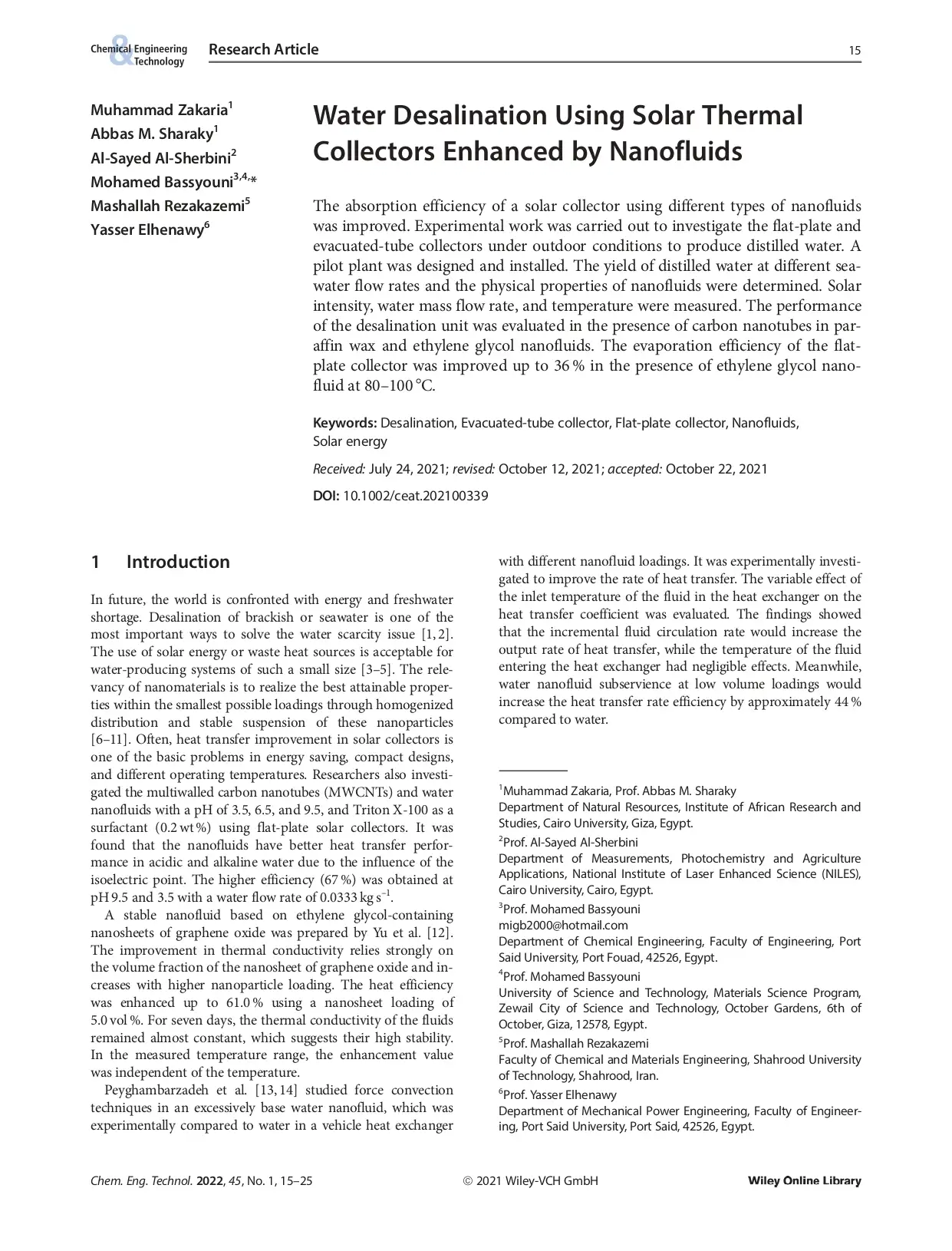
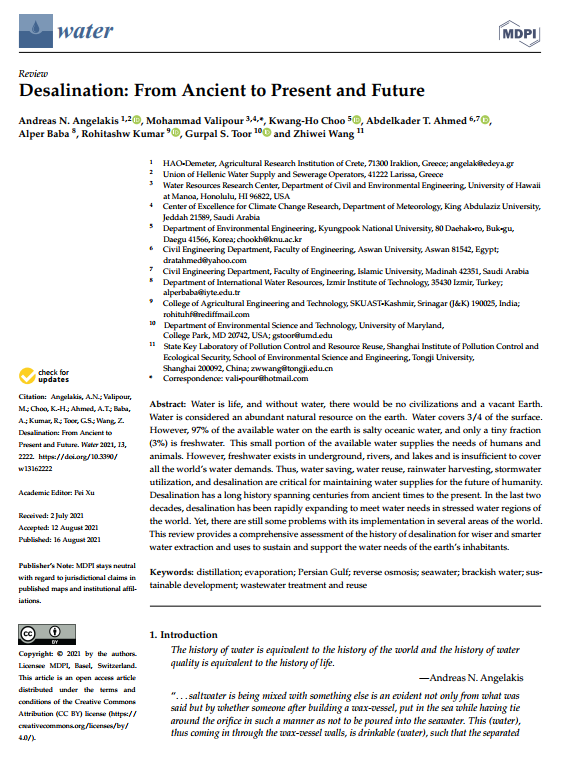
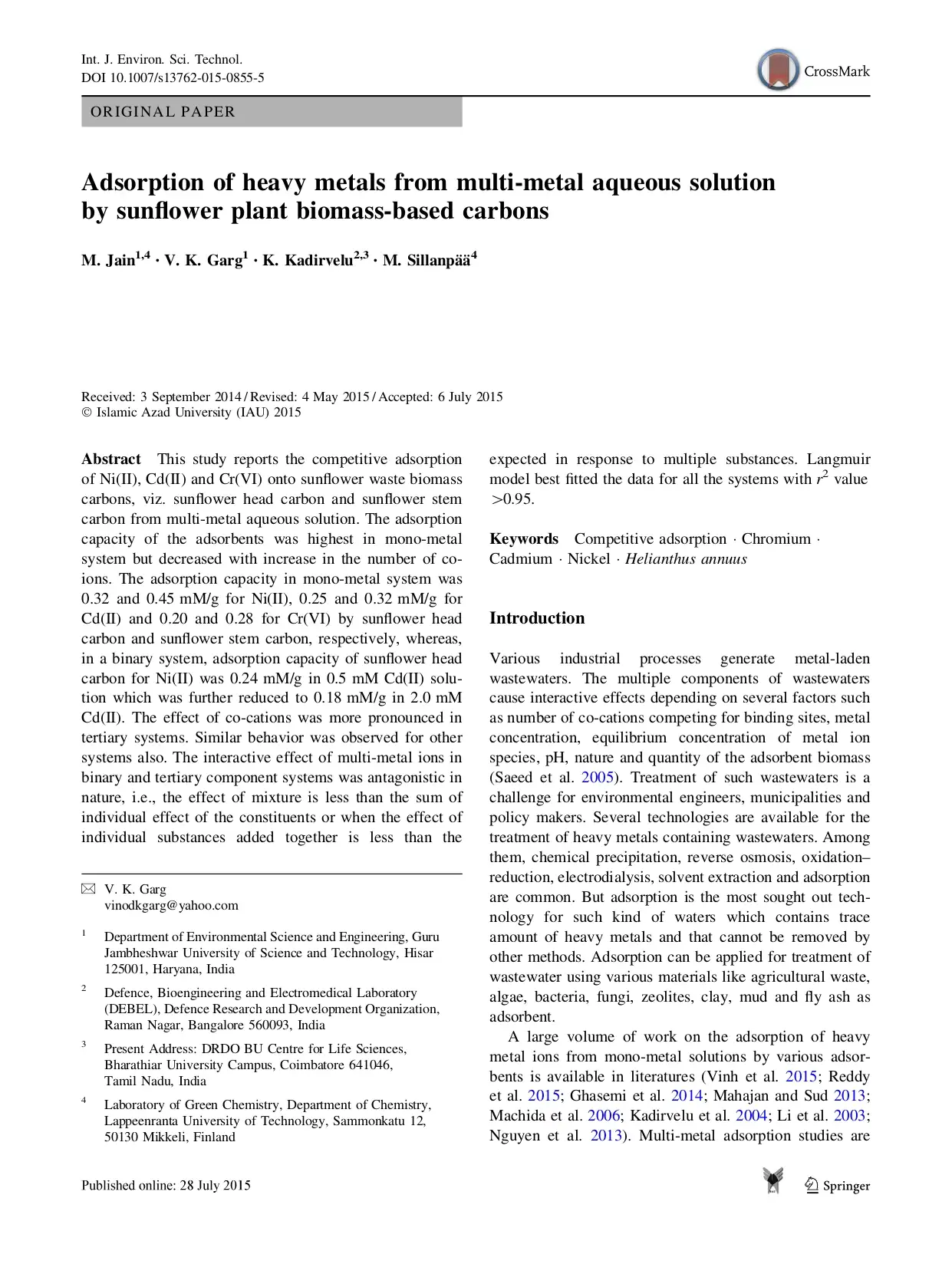



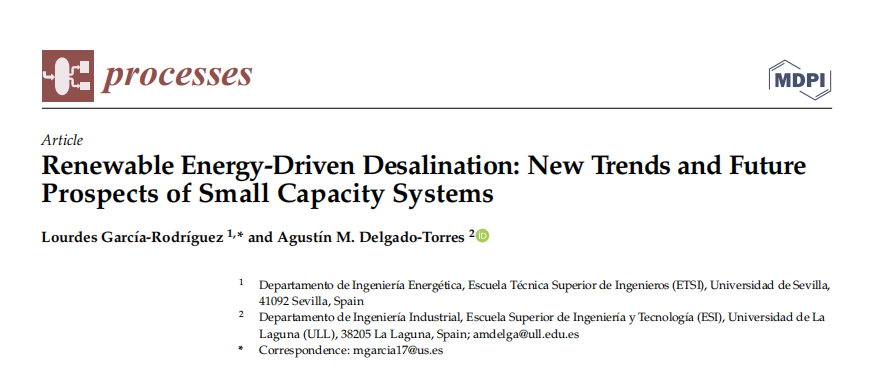
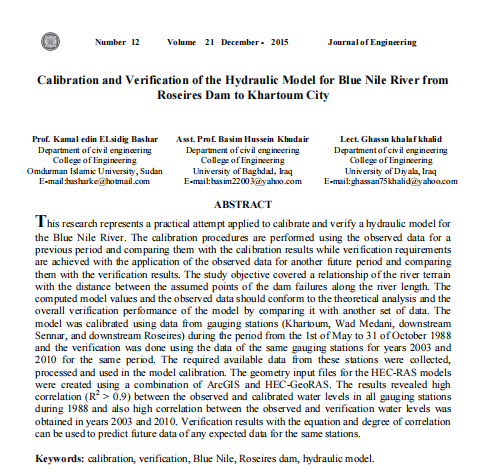
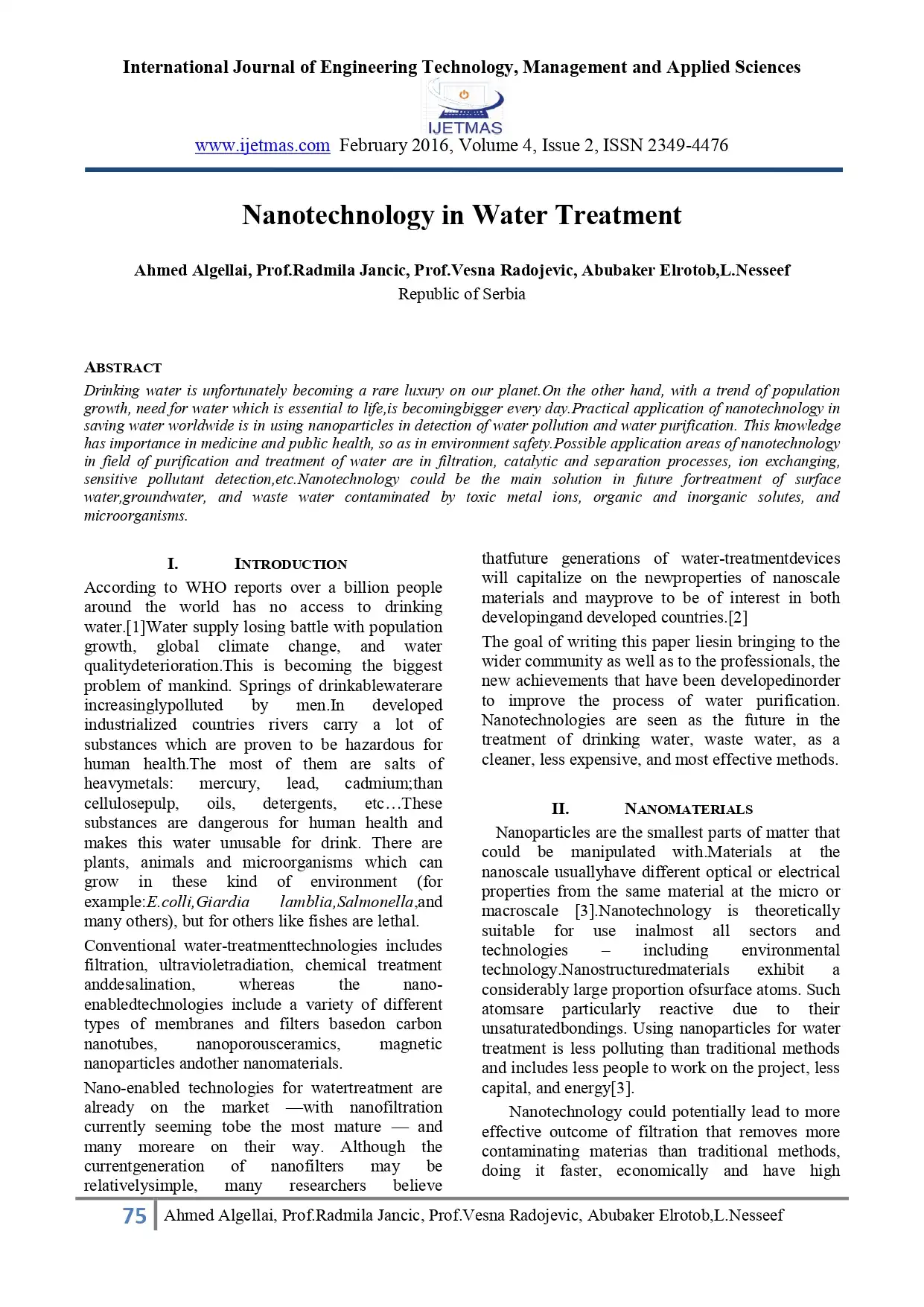
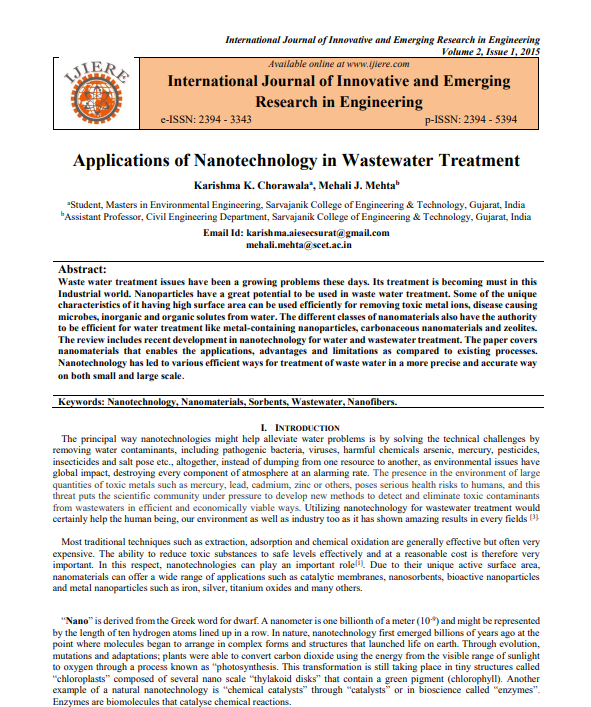

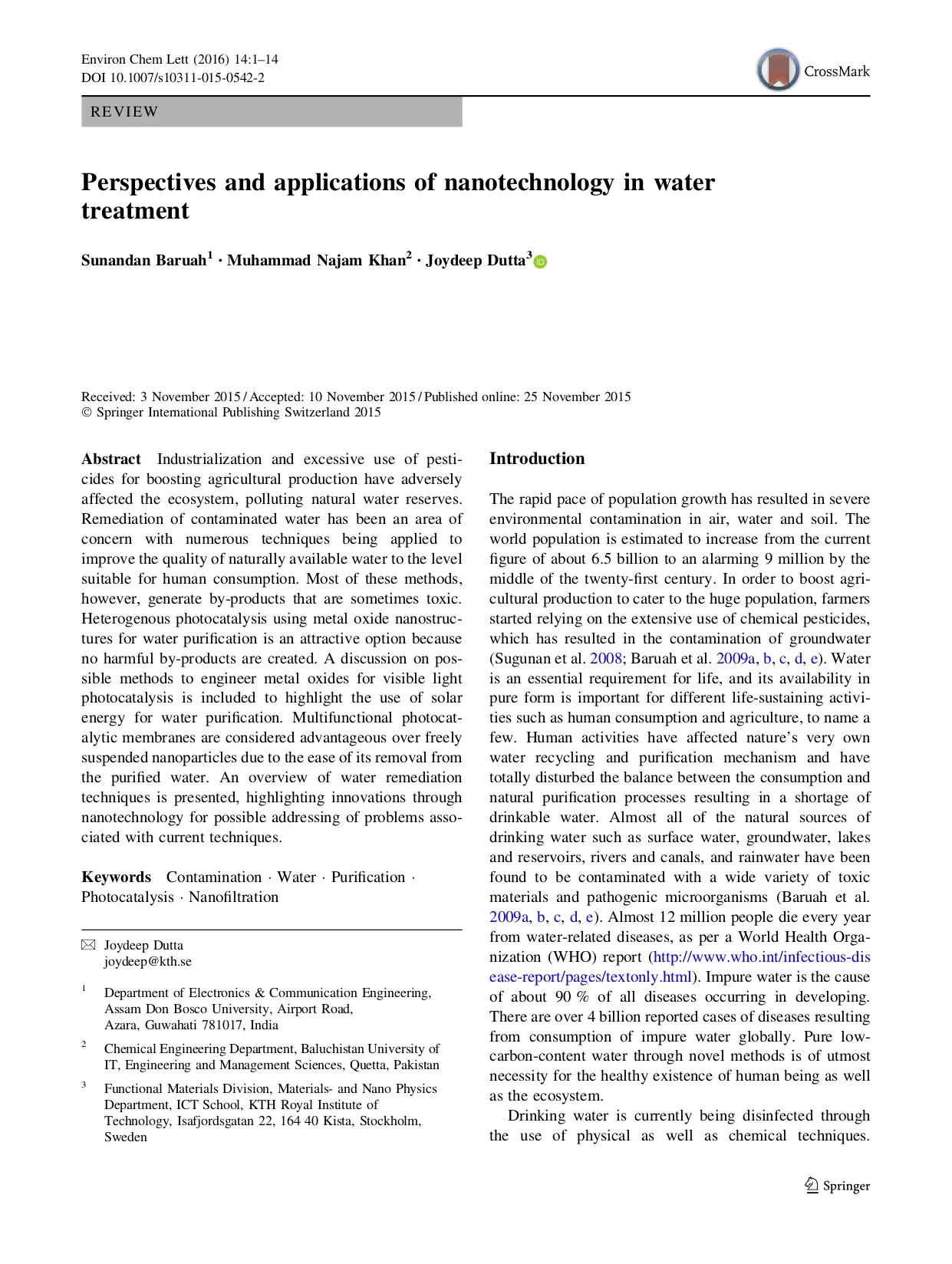
Reviews
There are no reviews yet.